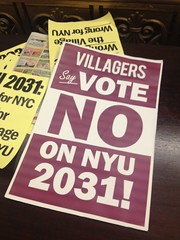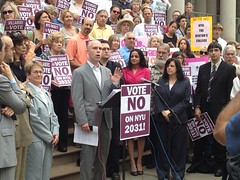The City Council hearing on New York University’s controversial expansion plan got a star cameo today, as Greenwich Village native Matthew Broderick argued that N.Y.U. 2031 would further strip the neighborhood of of its character. He was one of about 250 people who spoke out during the packed nine-hour meeting, with about 60 percent opposing the plan and 40 percent voicing their support.
Six hours before the actor testified, N.Y.U.’s president, John Sexton, started the hearing (which The Local liveblogged earlier today) by vigorously defending the project and the university’s need to expand. “This is not a development project. This is an academic project,” he said, explaining that more space was needed to recruit top-quality faculty and students.
Asked why N.Y.U. couldn’t look to other parts of the city, Mr. Sexton told council member Leroy Comrie that further dissipation of N.Y.U.’s activities across the city would amplify the perception that it doesn’t have a traditional campus “or a big football stadium where we gather,” turning off potential students.
“This is the most enlightened way to do this,” said Mr. Sexton, who also used his presentation to announce that a “huge initiative” for financial aid would be coming soon.
Council member Margaret Chin, who represents the Greenwich Village area, made clear her qualified opposition to N.Y.U.’s current plans. “I strongly believe this plan is unacceptable in its current form,” she said, calling it too ambitious but adding that she believed a compromise was possible. Mostly quiet during the hearing, Ms. Chin asked Mr. Sexton and other administrators – including Lynne Brown, Senior Vice President for University Relations and Public Affairs, and Alicia Hurley, Vice President for Government Affairs & Community Engagement – pointed questions about why more classes needed to be around the Washington Square Park area, rather than other areas of Manhattan.
Other council members took a similarly skeptical line with school officials, repeatedly asking whether the university couldn’t use its current space more effectively by increasing the number of Friday classes (Mr. Sexton said 10,000 students were in class every Friday, and faculty members dismissed reports of empty classrooms). Mr. Comrie and Ms. Chin, along with fellow council member Robert Jackson, also grilled officials on whether N.Y.U. had sufficient financing for the project (Mr. Sexton said it would not mean an increase in the school’s current yearly expenditures for new space).
Council member Garodnick pressed Ms. Hurley on whether the plan would leave Villagers with more or less green space. The administrator initially said there would be a net gain of three acres of publicly available space, but admitted that her calculations were based on considering the space that currently exists between the buildings as private.
“So there will be less open space because of the two new buildings?” Ms. Garodnick pressed.
“That’s fair,” Ms. Hurley said.
Other council members said they appreciated what N.Y.U. was doing academically and in certain parts of the community, citing its dental care van as an example. And dozens of current and former students complained about the difficulty of taking classes at reasonable hours and being unable to find study space in Bobst Library or book rooms for club activities. More space, they said, would alleviate those problems.
Mr. Broderick recalled his time growing up around Washington Square North, playing baseball and basketball in local parks, and watching the Washington Square Village buildings rise on a superblock that is marked for two “boomerang” buildings.
“There’s nothing wrong with those buildings, I realize, but they’re not, in my opinion, Village-y,” he said. “People still desperately want to live here, but I’m not sure people will if the quirkiness, gorgeousness and humanness keep disappearing.”
Mr. Broderick’s was the most notable voice of opposition, but not the most strident. Other opponents arrived to City Hall by 8:30 a.m. for a pre-hearing rally during which protestors chanted “Just vote no!” and displayed signs reading “Save our gardens” and “Villagers say vote no to NYU 2031.”
At the rally, Mark Crispin Miller, a leader of N.Y.U. Faculty Against the Sexton Plan, said that he understood that professors needed more space, but said he felt that “those legitimate claims are being used to justify this boondoggle.”
Community Board 2 chair David Gruber pointed to the 34 N.Y.U. departments that had voted against the plan. “It’s not a question of the East Village crazies coming out,” he said.
A final decision from the City Council is expected before the end of July, after which Mayor Bloomberg will have the final say.
This post has been revised to reflect the following correction:
Correction: June 30, 2012
An earlier version of this post misidentified the current chair of Community Board 2. It was David Gruber who said 34 departments voted against the plan, not Brad Hoylman.






